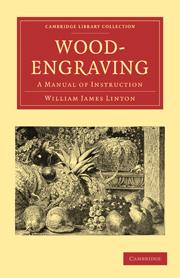Book contents
- Frontmatter
- PREFACE
- Contents
- ILLUSTRATIONS
- CHAPTER I Of engraving in relief
- CHAPTER II Of the history of Wood-Engraving
- CHAPTER III Of the difference between cutting and engraving
- CHAPTER IV Of the tools required for engraving on wood
- CHAPTER V Of drawing on wood for engraving
- CHAPTER VI Of the method of procedure in engraving
- CHAPTER VII Of things to be avoided
- CHAPTER VIII Of things to be aimed at
- CHAPTER IX Of beauty of line
- CHAPTER X Of the use and abuse of photography
- CHAPTER XI Of what constitutes an Artist
- CHAPTER XII of works for reference
- Index
- Plate section
CHAPTER X - Of the use and abuse of photography
Published online by Cambridge University Press: 29 August 2010
- Frontmatter
- PREFACE
- Contents
- ILLUSTRATIONS
- CHAPTER I Of engraving in relief
- CHAPTER II Of the history of Wood-Engraving
- CHAPTER III Of the difference between cutting and engraving
- CHAPTER IV Of the tools required for engraving on wood
- CHAPTER V Of drawing on wood for engraving
- CHAPTER VI Of the method of procedure in engraving
- CHAPTER VII Of things to be avoided
- CHAPTER VIII Of things to be aimed at
- CHAPTER IX Of beauty of line
- CHAPTER X Of the use and abuse of photography
- CHAPTER XI Of what constitutes an Artist
- CHAPTER XII of works for reference
- Index
- Plate section
Summary
THE use of Photography as an adjunct to Art has been very great. But Photography can not take the place of Art, and Art can not be the mere imitation of a photograph.
Here are some of the supposed advantages of photography as a substitute for drawing on wood, the matter which immediately concerns us here. I take them from a writer who is convinced that “we owe the improved character of our wood-engraving more to that than to any other cause.”
“It admits of the reduction of a drawing to a block of any desired size, and a freer handling so obtained,—drawing on the limited surface of a block having always been regarded by artists as a cramped business, the freest handling not attainable that way.”
I answer:—Any good draughtsman can make a correct reduction to any desired size: correct as the photograph in proportions, more correct than the photograph as to effect in the copy of a picture. The supposed impossibility of free handling on the smallest blocks is disproved by the works of Thurston, Harvey, Cruikshank, without need of naming others, German, English, French, and American. No freer handling can be found anywhere than in drawings on blocks sometimes not more than an inch square; nor did the artists I refer to ever regard drawing for engravers as “a cramped business.” If drawing on the scale required for wood-engravers be cramped, what is engraving?
- Type
- Chapter
- Information
- Wood-EngravingA Manual of Instruction, pp. 93 - 102Publisher: Cambridge University PressPrint publication year: 2010First published in: 1884

